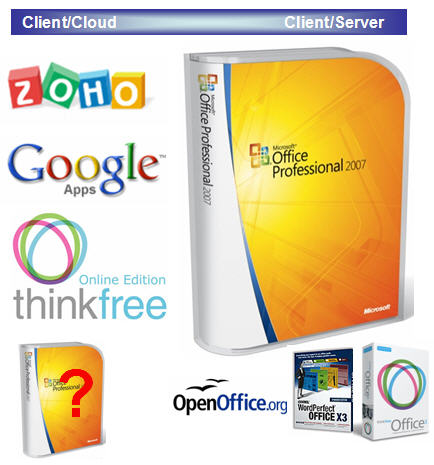The evolving Office suite landscape

For decades Microsoft Office has dominated the ‘productivity software’ landscape. The latest iteration, Office 2007, was released in late January, and it continues to thrive. Other office suites sailing in the same waters, such as WordPerfect Office and OpenOffice.org, have failed to slow down Microsoft’s Office.
Today the landscape is shifting, with cloud-based, on demand office suites built with collaboration in mind nibbling at Microsoft’s ankles.
Google Apps is most often mentioned online Microsoft Office competitor, especially Google Docs & Spreadsheets, but that has more to do with the powerful presence of Google than the competitiveness of its applications.
ThinkFree has both a desktop- and online-based office suite, including word processing, spreadsheet, and presentation modules that are 'compatible' with Microsoft Office.
Zoho has the most comprehensive online suite, word processing, spreadsheet, presentations, project management, CRM, database creation, wiki, planner, notebook, chat, Web conferencing, email, calendar and groupware. Most of the applications are free, as Zoho is focused on growing its user base, and the company plans to offer a Business Edition in the fall that includes an administration console for managing applications and users, similar to what Google Apps provides.
Microsoft executives claim that customers aren't asking for a cloud-based Office, but you can be sure that the company is working diligently on such a product. I would guess that next year Microsoft will pull the trigger on its online Office, which will complementary and deeply integrated with the more heavyweight desktop Office.
The idea of providing offline access for online applications is not lost on the upstarts. Today ThinkFree introduced a beta of ThinkFree Premium, which allows users to edit Microsoft Office files online and offline. A yearly subscription will be about $75 per year. Zoho offers a plug-in for Microsoft Office, which allows users to work offline on with Microsoft Word or Excel and have the changes synched with documents in Zoho Writer or Sheet.
Google recently in introduced Google Gears, an open source browser extension for providing online applications with offline functionality via JavaScript APIs. Zoho and salesforce.com plan to use Google Gears to bring offline access to their sets of applications.
In addition to the suite makers, software providers like salesforce.com and Cisco's WebEx have on demand platforms that can serve as development and delivery vehicles for the online suites and for custom productivity application functionality. In fact, the two companies are likely to acquire or partner with the online office makers to fill out their service offerings.
In a follow up post, I'll take a look at where Zoho is heading with its growing suite of online applications.
See also Richard MacManus comparison of online applications suites.
